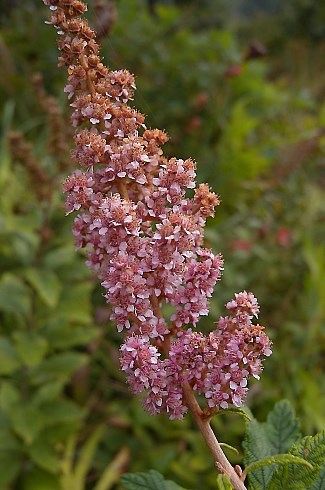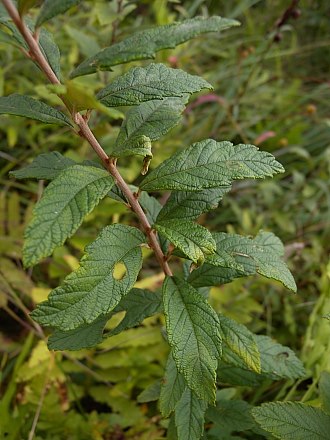Description: This shrub is 2-4' tall, more or less erect, and it is usually unbranched (see photo of Flowering Shrub). The central stem is terete and brown; it is initially covered with woolly brown hairs, but later becomes hairless and woody. Alternate leaves are abundant along the stem; they are 1½–3" long, ½–1¼" across, elliptic-oblong to ovate-oblong, somewhat leathery in texture, and coarsely toothed along their margins. The upper surfaces of the leaves are dark green and hairless, while their lower surfaces are more pale and covered with hairs that are tawny and woolly, particularly along the major veins. The petioles of the leaves are about ¼" long and and also covered with hairs that are tawny and woolly.

The central stem terminates in a dense panicle of pink
flowers
about 4-8" long and about one-third as much across. The panicle has a
narrowly pyramidal shape with short lateral branches that are ascending
or spreading. These branches are covered with short tawny hairs.
Individual flowers are a little less than ¼" across, consisting of a
short calyx with 5 teeth, 5 spreading petals that are usually pink
(less often white), a cluster of 5 pistils, and numerous exerted
stamens. The delicate petals are well-rounded and rather wrinkled. The
blooming period occurs from mid-summer to early fall and lasts about
1-2 months. The abundant flowers bloom from the top of the panicle
downward, gradually turning brown. There is no noticeable floral scent.
Each flower is replaced by 5 small brown follicles that are ovoid with
short beaks. Each follicle splits open at the apex to release several
slender seeds. The root system is woody and branching.
Cultivation:
The preference is full sun, wet to moist conditions, and an acidic
sandy soil. The woody stems often die down to the ground during the
winter.

Range & Habitat:
The native Steeplebush is an uncommon shrub that is largely restricted
to sandy
areas of NE Illinois and scattered counties elsewhere in the northern
section of the state (see Distribution
Map). Populations of this species have declined because of
urban sprawl, drainage projects, and various attempts at
agriculture. Habitats include soggy sandy
thickets, wet sand prairies, wet and sandy shrub prairies (where this
species is sometimes dominant), sandy marshes, bogs, and interdunal
swales near Lake Michigan. Steeplebush is found in high quality wetland
habitats.
Faunal Associations:
The flowers attract primarily bees, flies, and beetles; abundant pollen
is produced, but only small amounts of nectar. A rare butterfly, Lycaeides
melissa samuelis (Karner Blue), has been observed to nectar
at the flowers of Steeplebush. The caterpillars of the butterfly, Celastrina
argiolus (Spring/Summer Azure), feed on the flowers, buds,
and developing seed capsules of Spiraea spp., while
the caterpillars of some moths are known to feed on the leaves. These
moth species include Hydria undulata (Scallop Shell
Moth), Sicya macularia (Sharp-Lined Yellow), Paonias
excaecatus (Blind-Eyed Sphinx), Sphinx gordius
(Gordian Sphinx), Sphinx poecila (Northern Apple
Sphinx), and Evora hemidesma (Spiraea Leaf-Tier
Moth). With the exception of the last moth, all of these species are
polyphagous. Although White-Tailed Deer have been known to browse on
Steeplebush, it is not preferred as a source of food because of the
bitter and astringent foliage.
Photographic Location:
Edge of a wet sand prairie at the Iroquois County Conservation Area in
Illinois.
Comments:
Another common name of Spiraea tomentosa is
Hardhack, which refers to the toughness of the stems. Steeplebush is an
attractive small shrub that resembles the native Spiraea alba
(Meadowsweet), except the latter species has white flowers and it lacks
tawny woolly hairs on its stems, petioles, floral branches, and leaf
undersides. Meadowsweet is the more common of the two species, and it
adapts to a wider range of wetland habitats.